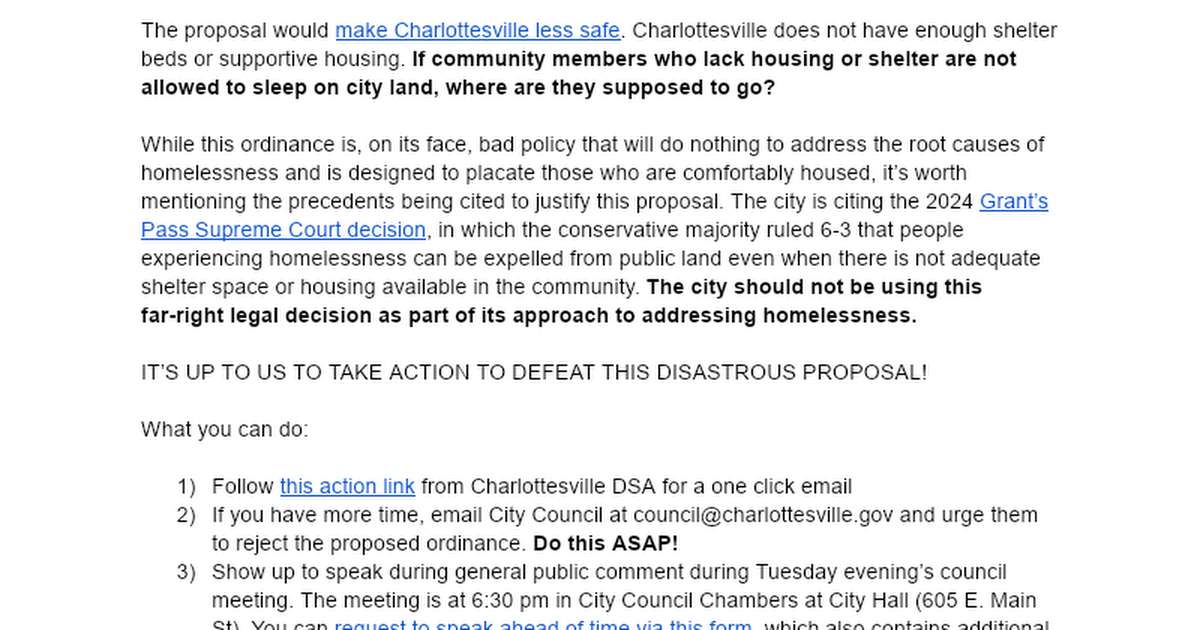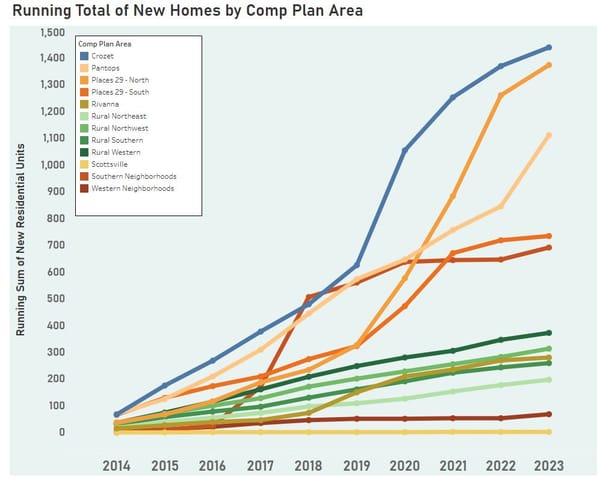Homelessness and the Charlottesville Metro Housing Market
As of writing this (August 31, 2025), the City of Charlottesville is poised to hear a proposed ordinance from the Chief of Police. The ordinance - to be evaluated at the September 2, 2025 Charlottesville City Council meeting - would criminalize "camping" and the "storage of personal property" on public right-of-ways in Charlottesville.
(For anyone who may think this sounds reasonable - walk with me on this. You are without a permanent home. You carry your worldly possessions in a backpack and a tote bag, and sleep in a tent beneath one of the city's bridges, in one of the gravel lots or underpasses, a dead space in the city. One day, a police officer informs you that in the next 24 hours they'll come to clean you out. You wait - where will you go? What will you do? - and then, true to their word, the police arrive. Your tent and bags are seized by armed police officers. Your possessions are removed or destroyed. You are fined $150 for a Class Four Misdemeanor. A nonprofit employee apologetically hands you a brochure for their rental counseling services and tells you they can get you on the waitlist for affordable housing. You are told you cannot sleep here anymore. You are left standing in the shadow of the bridge - if you're lucky, if you didn't resist, if you didn't curse or spit or flail at the indignity you're being forced to suffer - gaining nothing but debts, a debt of $150 to the City. You are told you can go pick up your backpack, tote, and tent from the police station - but any contaminated, hazardous, or ruined personal property will be thrown away, in the interest of the safety of the public servants who stripped you of the little you had left. If you had no criminal record, you have one now - a small blemish, the most minor of misdemeanors, but a misdemeanor all the same, just the kind of thing that comes up on background checks for rental housing. And you owe a fine - a fine you can contest, a fine you can delay and work out a payment plan for, but a fine nonetheless, and someone always comes to collect. You have been robbed, evicted, and shackled to new debts, all in the name of compassionate policing).
That's a non-specific hypothetical; if it sounds exaggerated or embellished, I'd encourage you read some actual accounts of sweeps: like this, or this, or this.
Good and decent people are already working hard to gather voices to speak against this ordinance. But I want to speak to another piece of the homelessness story in Charlottesville, a long-overdue accounting.
The City of Charlottesville and Albemarle County are two separate and distinct entities. Oh, there's a bevy of MOUs and partnerships and this-and-that; the County and City work together often, along with the Third Entity, the Big Grape, UVA itself. But I think for Albemarle County residents - particularly residents out my way, in Crozet - it's easy to fall into a comfortable pattern of thought: well, those are the City's problems, not the County's, so I can keep out.
And look, on one level: that's kinda true here. More voices are always good, but City officials listen more to City residents, and County officials listen more to County residents. So it can feel, if you live in Albemarle County, like this proposed ordinance for the City is not really your business. (For the record - it ain't true. We're all one community, and your voice matters no matter which side of the locality line you live on). But there's plenty to put at the feet of the Albemarle County Board of Supervisors. (And Fluvanna, and Nelson, and Greene, but I'm focusing on Albemarle, mostly).
What Does the Data Say About Homelessness?
Recent research (summarized in the great and well-titled book Homelessness is a Housing Problem)[1] has demonstrated very, very clearly that homelessness is inextricably and correlatively tied to the number of homes coming into the housing market. Specifically, the elasticity of the housing supply - how quickly supply responds to demand - has a very strong correlation with local rates of homelessness. Rent growth goes up and vacancy rates go down when you have a combination of population increase and inelasticity of the housing supply.
Between 2013 and 2023, the Charlottesville Metropolitan Area population increased by about 10%.[2] The total number of housing units tracked fairly well - about an 11% increase. But the number of housing units doesn't tell us the whole story of housing supply. And when we look at the lower end of housing in the Charlottesville Metro Area, we see that supply problem clearly. In 2013, about 35% of all rental units had rents less than $1,000 a month. A little more than one out of every three. But by 2023, that had decreased to 17% of all rental units - a drop from 9,675 to 4,896. One in every six.
Moreover, rental vacancy rates have plummeted in the last 10 years - from a moderately-healthy-but-still-low 5% in 2013 to a really-pretty-worrying 2.6% in 2023. Rental vacancy rates are a good metric of housing supply: higher vacancy rates tend to mean more supply of available housing, while dropping vacancy rates tend to show that available supply is getting filled quickly. (For reference - the city of New York [heard of it?] is facing a historic crisis with a 2023 vacancy rate around 1.4%. Housing advocates in New York often point to this as the big red neon sign saying HEY! OUR SUPPLY IS TOTALLY SCREWED UP!)
So we have total housing stock tracking roughly along population, but affordable units vanishing and vacancy rates plummeting. That would suggest that the housing being built is not affordable, or not even on the low-to-middle end of the housing market. That tracks alongside recent continued increases in the number of people experiencing homelessness on a given night - mostly recently estimated at 220 for the City, up from 200 the year before.[3]
One way to look at population and housing supply data is to compare the change in time from 2013/2023 across the two metrics. That is: what changed more, population or housing stock?
I found something that I find very, very interesting. I made a picture of it:

A few things probably jump out right away - like Nelson County losing both population and houses. Hopefully the next thing to stand out is all that white space next to Charlottesville. A big gap between the change in population (+5%) and the change in housing stock (+11%).
To make it more clear, here's just the difference between the two metrics, by locality:

The amount of housing stock in the City of Charlottesville outpaced population growth by 6%, while every other locality approximately matched change in population.
What Role Has Albemarle Played in Charlottesville's Homelessness Rates?
Ok, so we add that all up:
- Small, affordable units are vanishing
- Rental vacancy rates are plummeting
- The number of people experiencing homelessness is rising again recently
- Statistics tells us homelessness is directly correlated with housing supply
- The homes built in the last decade have not meaningfully contributed to affordable housing supply
- The City of Charlottesville outpaced population growth with new houses, while surrounding localities did not
Doing the math there, this describes to me a particular truth: the homelessness that is most starkly visible in the city limits of Charlottesville is in fact the outcome of insufficient housing supply - both in terms of quantity and quality, or natural affordability - in the surrounding counties, specifically Albemarle County. Or, to put some pith on it: Albemarle County's strangled housing supply is directly to blame for creating the conditions for homelessness in the City of Charlottesville.
Why put most of the blame on Albemarle, and not the other counties? For this simple reason: there's more people and more money in Albemarle, and the urban ring of Cville is inextricable from the city itself. If we assume that Charlottesville is the employment hub for our area - which it more or less is, with our hospitals and university, etc., etc. - we should be building housing close to those things.
The most recently available land use buildout analysis from Albemarle County suggests that we have enough land to match estimated population growth over the next twenty years. But if we look back over the last decade, it should be clear that matching population growth is not really a metric for success on its own.
It's not sufficient for Albemarle County to just shoot for matching estimated population totals in our residential buildout. We need proactive, decisive action. We need Albemarle County to use the upcoming zoning modernization as an opportunity to increase density wherever possible, most especially in the urban ring. We need Albemarle County to shift at minimum $10 million/year into the Affordable Housing Trust Fund - and to develop rigorous guidelines and requirements for the use of that money. We need Albemarle County to pour money into permanent supportive housing. Vista29 (formerly Red Carpet Inn, formerly Premier Circle) is a start , but we need more, and the County can do more. We need Albemarle County to avoid policing models like the hokum described at the top of this article.
We need houses, and we need them in Albemarle County. We need small houses, built closely together, ideally with some form of public subsidy underpinning the rent or sale price for some or all of those homes. Because homelessness is bigger than just a City of Charlottesville problem. It's something we all inflict through our policy decisions. When our county governments are responsible for a problem, we're all responsible for fixing it. We owe our neighbors better than crude policing tactics and weak, empty suggestions of "compassion," and we who live outside the City of Charlottesville must own the responsibility we bear.
If you are inspired to immediate action on the City's proposed ordinance: follow the links in this thread posted by Livable Cville, and/or view the action alert below: https://bsky.app/profile/livablecville.bsky.social/post/3lxrxv6d2jc2d

If you are inspired to further action: reach out to the County Board of Supervisors to let them know how you believe the County can take decisive action.
References
[1] Homelessness is a Housing Problem website: https://homelessnesshousingproblem.com/
[2] Data from Housing Needs Assessment tool, which in turn uses data from St. Louis FRED, US Census, ACS, and other federal sources. https://www.localhousingsolutions.org/housing-needs-assessment/
[3] Erin O'Hare, Charlottesville Tomorrow, Unhoused population in Charlottesville area keeps growing, despite efforts from city and nonprofits https://www.cvilletomorrow.org/unhoused-population-in-charlottesville-area-keeps-growing-despite-efforts-from-city-and-nonprofits/



